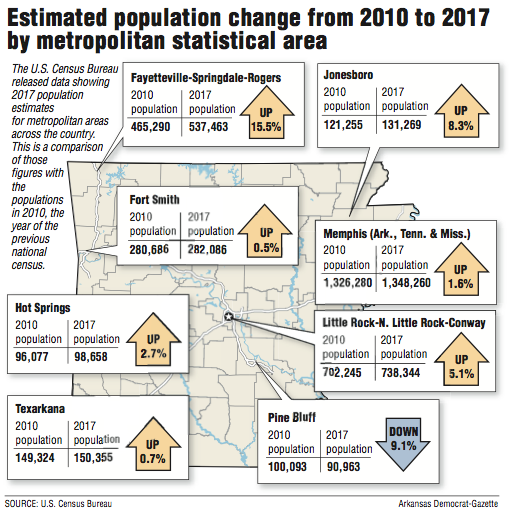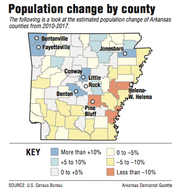The county that grew the most and the county that grew the least in 2017 are in opposite corners of Arkansas and highlight continuing trends of prosperity and decline in the Natural State, according to the latest U.S. Census Bureau Population Estimates released publicly today.
Two years out from the next full Census, demographic and economic experts said they anticipate population changes that would alter political boundaries and potentially suggest changing priorities for the state.
Since 2010 -- and even before that, experts say -- most metropolitan areas in Arkansas and across the United States have added to their populations, while about half of micropolitan areas, those urban areas with populations of at least 10,000 but less that 50,000, in Arkansas and across the U.S. shrank.
That's been seen in counties, too.
[INTERACTIVE MAPS: See population changes in state]
From 2016 to 2017, 40 of Arkansas' 75 counties shrank. But together those counties' populations made up only 806,346 people in 2017. In the state's 35 counties that showed growth, the total population was estimated at 2,197,933.
Benton County in Northwest Arkansas grew 3.57 percent from 2016 to 2017, capping a population increase of 15 percent since 2010, from an estimated 231,564 people in 2010 to an estimated 266,300 in 2017.
Chicot County in southeast Arkansas shrank 3.19 percent from 2016 to 2017, from an estimated 11,800 people in 2010 to 10,636 people in 2017, a decrease of 9.86 percent.
The populations in Northwest Arkansas and central Arkansas, which have lower poverty and higher income, have grown year after year since 2010 while much of state's south and east, where poverty rates are higher and income is lower, have seen their populations contract, according to an Arkansas Democrat-Gazette analysis of several Census Bureau data sets.
The Fayetteville-Springdale-Rogers-southern Missouri metropolitan area was the 14th-fastest growing area in the United States in 2017, up from 22nd last year.
The four-county Fayetteville-Springdale-Rogers metropolitan statistical area added roughly 12,000 people from mid-2016 to mid-2017, an average of nearly 34 people per day. It's the same growth rate by percentage as in the previous two years and only slightly higher than the four years before that.
Arkansas' total population in 2017 was 3,004,279, according to the data, up from 2,988,599 in 2016 and 2,910,236 in 2010, increases of 0.5 percent and 3.2 percent, respectively.
The total U.S population rose from 323,627,251 in 2016 to 325,696,622 in 2017, an increase of 0.6 percent. It rose from 309,022,505 in 2010, an increase of 5.4 percent.
The Dallas-Fort Worth-Arlington metro area was the nation's fastest-growing area in 2017, increasing by about 146,000 people. Six of the 10 counties that gained the most people in 2017 were in Texas: four in the Dallas area, San Antonio's Bexar County and Houston's Harris County.
The Census Bureau said many of the largest metro areas rely mostly on international migrants and natural increase -- the number of births that exceeded the number of deaths -- to grow, but the Dallas area did not.
The Census Bureau's estimates include components of population change -- births, deaths and domestic and international migration -- but they are only estimates.
The data also include a category for residuals, which represents the change in population that cannot be attributed to any specific demographic. International migrants also do not necessarily indicate immigration; they could indicate a soldier returning from overseas deployment, according to the Census Bureau.
But population changes, experts say, can include populations -- such as people migrating from rural to urban areas that have more amenities and economic opportunities.
Migration is important for continued economic growth, according to Pam Willrodt, a demographer at the Arkansas Economic Development Institute, because younger people aren't having as many children as older generations.
"It's just expensive," Willrodt said.
Younger people especially desire to live in more urban areas, said Mervin Jebaraj, director of the Center for Business and Economic Research at the University of Arkansas, Fayetteville.
Urban areas growing the most have more diverse economies, Jebaraj said, and the latest numbers for Arkansas appear to reflect that. Myriad industries and institutes of higher education populate central, northwest and northeast Arkansas.
The Jonesboro area in northeast Arkansas was the second-fastest growing metro area in the state from 2016 to 2017 and from 2010 to 2017, growing 1.14 percent from 2016 and 8.26 percent since 2010. It now has an estimated 131,269 people, up from 121,255 estimated in 2010.
Arkansas State University, hospitals and factories are expanding, said Bill Campbell, a spokesman for the city. The city is also expanding amenities of its own, including Craighead Park and Miracle League Park for people with disabilities.
The Little Rock-North Little Rock-Conway metro area was the state's third-fastest growing metro area from 2016 to 2017 and from 2010 to 2017. Home to the state capital, numerous hospitals, universities and corporations, the area grew mostly because of the birth rate, according to Census estimates.
In contrast, the Census estimated most of Northwest Arkansas' growth was because of domestic and international migrants. Jebaraj said migrants are likely the only way the region could grow as it has because young families that are already here couldn't have children fast enough for such an increase.
Most are probably coming for jobs they've lined up rather than transplanting and hunting for work after they get to the area, Jebaraj added. He said they also help draw money into attractive amenities such as the Razorback Greenway, parks or arts and cultural venues.
New arrivals have included people recruited to corporate headquarters, others who come for work at food production plants, and families reuniting or seeking educational opportunities, according to researchers, civic leaders and many of the newcomers themselves.
The international migrant estimates suggest several long-running challenges for the region will continue. School districts, particularly in Springdale and Rogers, have expanded English Language Learner programs for immigrant students and created programs to help their parents navigate the education system, for instance. Elected leaders for the districts and local governments also don't reflect the racial and ethnic diversity of their communities so far.
In the Pine Bluff metropolitan area, 1,633 more people left the city in the last year than moved to it. That's par for the course in the Delta town, where the Census Bureau estimated the number of births in 2017 slightly outpaced the number of deaths and a handful more international migrants moved in than left. The area hasn't recovered from a loss of manufacturing plants.
Pine Bluff was the only one among Arkansas' seven metropolitan areas to shrink in 2017.
Officials in Pine Bluff and Chicot County did not return messages left for them Wednesday.
While the 2017 figures are only approximations of population changes, Jebaraj said they point to potentially consequential trends for the state.
"I think it tells us what the future holds for the state of Arkansas," he said.
Once the 2020 Census is complete, it will trigger the redrawing of Congressional and state legislative districts to account for population shifts.
Based on the past eight years of data, more legislative districts will be urban, Jebaraj said, and legislative priorities could change along with it.
Census figures, including population, also can affect federal funding for a particular area, said Willrodt.
She noted that while Arkansas remains more rural than other states, it is becoming more urban.
"That means the policymakers need to look at the state through a different lens than they have in recent years," Jebaraj* said.
For example, Willrodt said, lawmakers pay a lot of attention to rural economic needs, but infrastructure in areas of higher growth could end up being more of a priority.
Information for this article was contributed by Dan Holtmeyer of the Northwest Arkansas Democrat-Gazette.
RELATED ARTICLE
http://www.arkansas…">Report: Growth continues in Northwest Arkansas
Metro on 03/22/2018
*CORRECTION: Mervin Jebaraj, director of the Center for Business and Economic Research at the University of Arkansas, Fayetteville, said policymakers will have to look at the state through a different lens in light of changing population distribution in Arkansas. A previous version of this article about the Census attributed the quotation to the wrong person.


